Pioneer s-htd320, xv-htd320 User Manual
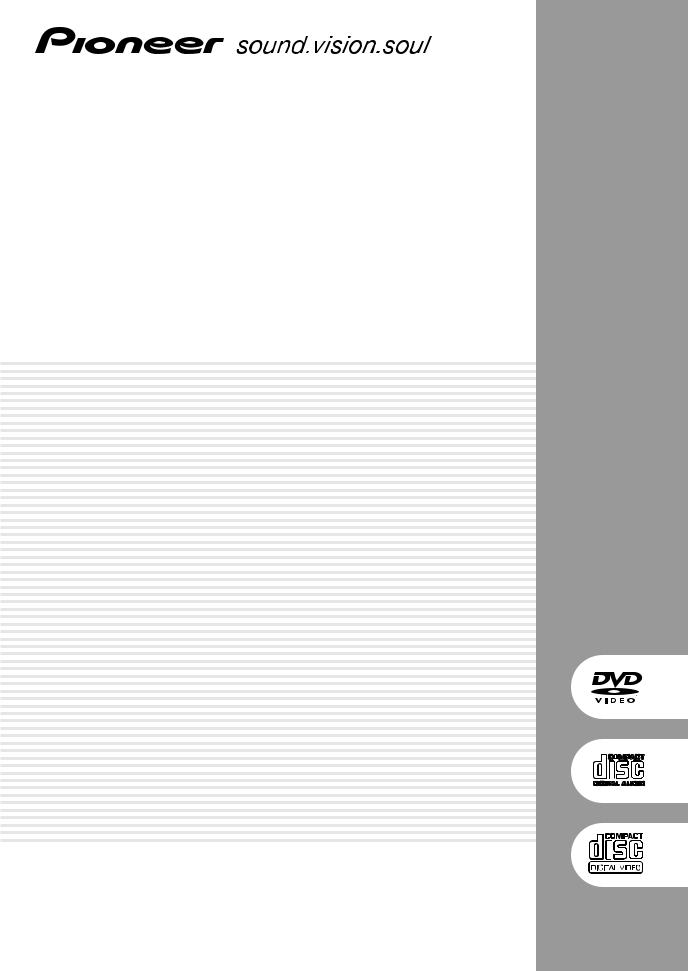
DVD RECEIVER RECEPTEUR DVD
XV-HTD320
SPEAKER SYSTEM ENCEINTES ACOUSTIQUES
S-HTD320
Operating Instructions Mode d’emploi

WARNING: TO PREVENT FIRE OR SHOCK HAZARD, DO NOT EXPOSE THIS APPLIANCE TO RAIN OR MOISTURE.
IMPORTANT
CAUTION
The lightning flash with arrowhead symbol, within an equilateral triangle, is intended to alert the user to the presence of uninsulated "dangerous voltage" within the product's enclosure that may be of sufficient magnitude to constitute a risk of electric shock to persons.
RISK OF ELECTRIC SHOCK
DO NOT OPEN
CAUTION:
TO PREVENT THE RISK OF ELECTRIC SHOCK, DO NOT REMOVE COVER (OR BACK). NO USERSERVICEABLE PARTS INSIDE. REFER SERVICING TO QUALIFIED SERVICE PERSONNEL.
The exclamation point within an equilateral triangle is intended to alert the user to the presence of important operating and maintenance (servicing) instructions in the literature accompanying the appliance.
[FOR U.S. MODEL] CAUTION
•Use of controls or adjustments or performance of procedures other than those specified herein may result in hazardous radiation exposure.
•The use of optical instruments with this product will increase eye hazard.
Information to User
Alteration or modifications carried out without appropriate authorization may invalidate the user’s right to operate the equipment.
Note: This equipment has been tested and found to comply with the limits for a Class B digital device, pursuant to Part 15 of the FCC Rules. These limits are designed to provide reasonable protection against harmful interference in a residential installation. This equipment generates, uses, and can radiate radio frequency energy and, if not installed and used in accordance with the instructions, may cause harmful interference to radio communications. However, there is no guarantee that interference will not occur in a particular installation. If this equipment does cause harmful interference to radio or television reception, which can be determined by turning the equipment off and on, the user is encouraged to try to correct the interference by one or more of the following measures:
–Reorient or relocate the receiving antenna.
–Increase the separation between the equipment and receiver.
–Connect the equipment into an outlet on a circuit different from that to which the receiver is connected.
–Consult the dealer or an experienced radio/TV technician for help.
IMPORTANT NOTICE
[For U.S. model]
The serial number for this equipment is located on the rear panel. Please write this serial number on your enclosed warranty card and keep it in a secure area. This is for your security.
THE STANDBY/ON BUTTON IS SECONDARY CONNECTED AND THEREFORE DOES NOT SEPARATE THE UNIT FROM MAINS POWER IN STANDBY POSITION.
[For Canadian model]
CAUTION: TO PREVENT ELECTRIC SHOCK DO NOT USE THIS (POLARIZED) PLUG WITH AN EXTENSION CORD, RECEPTACLE OR OTHER OUTLET UNLESS THE BLADES CAN BE FULLY INSERTED TO PREVENT BLADE EXPOSURE.
ATTENTION: POUR PREVENIR LES CHOCS ELECTRIQUES NE PAS UTILISER CETTE FICHE POLARISEE AVEC UN PROLONGATEUR, UNE PRISE DE COURANT OU UNE AUTRE SORTIE DE COURANT, SAUF SI LES LAMES PEUVENT ETRE INSERESS A FOND SANS EN LAISSER AUCUNE PARTIE A DECOUVERT.
[For Canadian model]
This Class B digital apparatus complies with Canadian ICES-003.
[Pour le modèle Canadien]
Cet appareil numérique de la classe B est conforme à la norme NMB-003 du Canada.
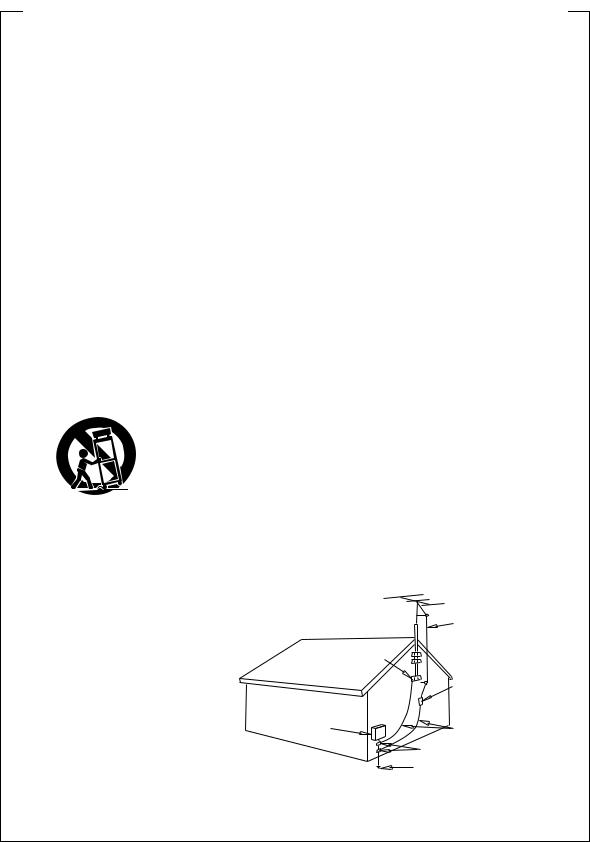
IMPORTANT SAFETY INSTRUCTIONS
READ INSTRUCTIONS — All the safety and operating instructions should be read before the product is operated.
RETAIN INSTRUCTIONS — The safety and operating instructions should be retained for future reference.
HEED WARNINGS — All warnings on the product and in the operating instructions should be adhered to.
FOLLOW INSTRUCTIONS — All operating and use instructions should be followed.
CLEANING — Unplug this product from the wall outlet before cleaning. The product should be cleaned only with a polishing cloth or a soft dry cloth. Never clean with furniture wax, benzine, insecticides or other volatile liquids since they may corrode the cabinet.
ATTACHMENTS — Do not use attachments not recommended by the product manufacturer as they may cause hazards.
WATER AND MOISTURE — Do not use this product near water — for example, near a bathtub, wash bowl, kitchen sink, or laundry tub; in a wet basement; or near a swimming pool; and the like.
ACCESSORIES — Do not place this product on an unstable cart, stand, tripod, bracket, or table. The product may fall, causing serious injury to a child or adult, and serious damage to the product. Use only with a cart, stand, tripod, bracket, or table recommended by the manufacturer, or sold with the product. Any mounting of the product should follow the manufacturer’s instructions, and should use a mounting accessory recommended by the manufacturer.
CART — A product and cart combination should be moved with care. Quick stops, excessive force, and uneven surfaces may cause the product and cart combination to overturn.
VENTILATION — Slots and openings in the cabinet are provided for ventilation and to ensure reliable operation of the product and to protect it from overheating, and these openings must not be blocked or covered. The openings should never be blocked by placing the product on a bed, sofa, rug, or other similar surface. This product should not be placed in a built-in installation such as a bookcase or rack unless proper ventilation is provided or the manufacturer’s instructions have been adhered to.
POWER SOURCES — This product should be operated only from the type of power source indicated on the marking label. If you are not sure of the type of power supply to your home, consult your product dealer or local power company.
LOCATION – The appliance should be installed in a stable location.
NONUSE PERIODS – The power cord of the appliance should be unplugged from the outlet when left unused for a long period of time.
GROUNDING OR POLARIZATION
÷If this product is equipped with a polarized alternating current line plug (a plug having one blade wider than the other), it will fit into the outlet only one way. This is a safety feature. If you are unable to insert the plug fully into the outlet, try reversing the plug. If the plug should still fail to fit, contact your electrician to replace your obsolete outlet. Do not defeat the safety purpose of the polarized plug.
÷If this product is equipped with a three-wire grounding type plug, a plug having a third (grounding) pin, it will only fit into a grounding type power outlet. This is a safety feature. If you are unable to insert the plug into the outlet, contact your electrician to replace your obsolete outlet.
Do not defeat the safety purpose of the grounding type plug.
POWER-CORD PROTECTION — Power-supply cords should be routed so that they are not likely to be walked on or pinched by items placed upon or against them, paying particular attention to cords at plugs, convenience receptacles, and the point where they exit from the product.
OUTDOOR ANTENNA GROUNDING — If an outside antenna or cable system is connected to the product, be sure the antenna or cable system is grounded so as to provide some protection against voltage surges and built-up static charges. Article 810 of the National Electrical Code, ANSI/NFPA 70, provides information with regard to proper grounding of the mast and supporting structure, grounding of the lead-in wire to an antenna discharge unit, size of grounding conductors, location of antenna-discharge unit, connection to grounding electrodes, and requirements for the grounding electrode. See Figure A.
LIGHTNING — For added protection for this product during a lightning storm, or when it is left unattended and unused for long periods of time, unplug it from the wall outlet and disconnect the antenna or cable system. This will prevent damage to the product due to lightning and power-line surges.
POWER LINES — An outside antenna system should not be located in the vicinity of overhead power lines or other electric light or power circuits, or where it can fall into such power lines or circuits. When installing an outside antenna system, extreme care should be taken to keep from touching such power lines or circuits as contact with them might be fatal.
OVERLOADING — Do not overload wall outlets, extension cords, or integral convenience receptacles as this can result in a risk of fire or electric shock.
GROUND
CLAMP
ELECTRIC
SERVICE
EQUIPMENT
Fig. A
OBJECT AND LIQUID ENTRY — Never push objects of any kind into this product through openings as they may touch dangerous voltage points or short-out parts that could result in a fire or electric shock. Never spill liquid of any kind on the product.
SERVICING — Do not attempt to service this product yourself as opening or removing covers may expose you to dangerous voltage or other hazards. Refer all servicing to qualified service personnel.
DAMAGE REQUIRING SERVICE — Unplug this product from the wall outlet and refer servicing to qualified service personnel under the following conditions:
÷When the power-supply cord or plug is damaged.
÷If liquid has been spilled, or objects have fallen into the product.
÷If the product has been exposed to rain or water.
÷If the product does not operate normally by following the operating instructions. Adjust only those controls that are covered by the operating instructions as an improper adjustment of other controls may result in damage and will often require extensive work by a qualified technician to restore the product to its normal operation.
÷If the product has been dropped or damaged in any way.
÷When the product exhibits a distinct change in
performance — this indicates a need for service.
REPLACEMENT PARTS — When replacement parts are required, be sure the service technician has used replacement parts specified by the manufacturer or have the same characteristics as the original part. Unauthorized substitutions may result in fire, electric shock, or other hazards.
SAFETY CHECK — Upon completion of any service or repairs to this product, ask the service technician to perform safety checks to determine that the product is in proper operating condition.
WALL OR CEILING MOUNTING — The product should not be mounted to a wall or ceiling.
HEAT — The product should be situated away from heat sources such as radiators, heat registers, stoves, or other products (including amplifiers) that produce heat.
ANTENNA
LEAD IN
WIRE
ANTENNA DISCHARGE UNIT (NEC SECTION 810-20)
GROUNDING CONDUCTORS (NEC SECTION 810-21)
GROUND CLAMPS
POWER SERVICE GROUNDING ELECTRODE SYSTEM
(NEC ART 250, PART H)
NEC — NATIONAL ELECTRICAL CODE

Energy-saving design
This system is designed to use 1W of electricity when power is switched to Standby.
Design économie d’énergie
Cet appareil est conçu pour utiliser 1 W d’électricité quand l’alimentation est en veille.
This product is for general household purposes. Any failure due to use for other than household purposes (such as longterm use for business purposes in a restaurant or use in a car or ship) and which requires repair will be charged for even during the warranty period.
Ce lecteur est un produit grand public destiné à un usage domestique. Si vous l’utilisez à d’autres fins (par exemple, pour la sonorisation d’un restaurant, ou bien dans un véhicule ou un bateau), les réparations éventuelles vous seront facturées, même s’il est encore sous garantie.
|
|
|
|
IC |
IN |
D |
|
|
|
|
|
|
|
|
|
|
N |
|
|
|
|
|
|
|
|
||
|
|
|
O |
|
|
S |
|
|
|
|
|
|
|
|
T |
R |
|
|
|
U |
|
|
|
|
|
|
|
|
|
|
|
|
|
|
|
|
|
|
|
||
C |
|
|
|
|
|
|
R |
|
|
|
|
|
|
|
|
|
|
|
|
|
I |
|
|
|
|
||
E |
|
|
|
|
|
|
|
E |
|
|
|
|
|
L |
|
|
|
|
|
|
|
|
|
|
|||
E |
|
|
|
|
|
|
S |
|
|
|
|
||
A |
EST |
1924 |
N |
• |
|
|
|
|
|||||
|
|
S |
|
|
|
|
|
|
|
|
|
||
• |
|
|
|
|
|
|
|
|
|
|
|
||
|
|
|
S |
|
|
IO |
|
|
|
We |
|
|
|
|
|
|
|
O CIAT |
|
|
|
Want You |
|
||||
LISTENING
For A Lifetime
Selecting fine audio equipment such as the unit you’ve just purchased is only the start of your musical enjoyment. Now it’s time to consider how you can maximize the fun and excitement your equipment offers. This manufacturer and the Electronic Industries Association’s Consumer Electronics Group want you to get the most out of your equipment by playing it at a safe level. One that lets the sound come through loud and clear without annoying blaring or distortion-and, most importantly, without affecting your sensitive hearing.
Sound can be deceiving. Over time your hearing “comfort level” adapts to higher volumes of sound. So what sounds “normal” can actually be loud and harmful to your hearing. Guard against this by setting your equipment at a safe level BEFORE your hearing adapts.
To establish a safe level:
÷Start your volume control at a low setting.
÷Slowly increase the sound until you can hear it comfortably and clearly, and without distortion.
Once you have established a comfortable sound level:
÷ Set the dial and leave it there.
Taking a minute to do this now will help to prevent hearing damage or loss in the future. After all, we want you listening for a lifetime.
We Want You Listening ForALifetime
Used wisely, your new sound equipment will provide a lifetime of fun and enjoyment. Since hearing damage from loud noise is often undetectable until it is too late, this manufacturer and the Electronic Industries Association’s Consumer Electronics Group recommend you avoid prolonged exposure to excessive noise. This list of sound levels is included for your protection.
Decibel
Level Example
30 Quiet library, soft whispers
40 Living room, refrigerator, bedroom away from traffic
50 Light traffic, normal conversation, quiet office
60 Air conditioner at 20 feet, sewing machine
70 Vacuum cleaner, hair dryer, noisy restaurant
80 Average city traffic, garbage disposals, alarm clock at two feet.
THE FOLLOWING NOISES CAN BE DANGEROUS UNDER CONSTANT EXPOSURE
90 Subway, motorcycle, truck traffic, lawn mower
100 Garbage truck, chain saw, pneumatic drill
120 Rock band concert in front of speakers, thunderclap
140 Gunshot blast, jet plane
180 Rocket launching pad
Information courtesy of the Deafness Research Foundation.
|
|
|
|
IC |
IN |
D |
|
|
|
|
|
|
|
|
|
|
|
N |
|
|
|
|
|
|
|
||
|
|
R |
O |
|
|
U |
|
|
|
|
|
|
|
|
T |
|
|
|
|
S |
|
|
|
|
|
|
|
C |
|
|
|
|
T |
|
|
|
|
|
|||
|
|
|
|
|
|
R |
|
|
|
|
|
||
|
|
|
|
|
|
|
I |
|
|
|
|
|
|
E |
|
|
|
|
|
|
|
E |
|
|
|
|
|
L |
|
|
|
|
|
|
|
|
|
|
|
||
E |
|
|
|
|
|
|
S |
|
|
|
|
|
|
|
|
|
|
|
|
|
|
|
We |
||||
• |
|
EST |
1924 |
|
• |
Want You |
|||||||
A |
|
||||||||||||
|
|
|
|
S O C IAT |
|
|
LISTENING |
||||||
|
|
S |
|
|
ION |
|
|
|
|
|
|
||
For A Lifetime

Thank you for buying this Pioneer product.
Please read through these operating instructions so you will know how to operate your model properly. After you have finished reading the instructions, put them away in a safe place for future reference.
In some countries or regions, the shape of the power plug and power outlet may sometimes differ from that shown in the explanatory drawings. However the method of connecting and operating the unit is the same.
Contents
1 Before You Start
Features |
7 |
Exchanging discs |
|
What’s in the box |
8 |
Listening to the radio |
|
Using this manual |
8 |
Improving FM stereo sound |
|
Putting the batteries in |
|
Saving station presets |
|
the remote control |
8 |
Listening to station presets |
|
Using the remote control |
9 |
Listening to other components |
|
Hints on installation |
9 |
|
|
Avoiding problems with |
|
6 Using Surround Sound |
|
condensation |
10 |
Adjusting the bass and treble |
|
Movingthesystem |
10 |
||
Using P.Bass |
|||
Discscompatiblewiththissystem |
11 |
||
Using sound modes |
|||
DVDVideoregions |
11 |
||
Listening to surround-sound |
|||
|
|
||
2 Connecting Up |
|
sources |
|
|
Adjusting the effect level |
||
Connectingthespeakers |
12 |
Listening at low volume |
|
Placingthespeakers |
13 |
Direct recording |
|
Wall mounting the rear speaker |
|
|
|
system |
14 |
7 Playing Discs |
|
ConnectingtoyourTV |
15 |
Introduction |
|
Connectingthesuppliedantennas |
16 |
||
Finding what you want on a disc |
|||
AMloopantenna |
16 |
||
Switching camera angles |
|||
FMwireantenna |
17 |
||
Switching subtitles |
|||
Connectingexternalantennas |
17 |
||
Switching audio language |
|||
ExternalAMantenna |
17 |
||
Switching audio channel |
|||
ExternalFMantenna |
17 |
||
Making a program list |
|||
Connectingothercomponents |
18 |
||
More programming options |
|||
Connectingthepower |
18 |
||
Using random play |
|||
|
|
||
3 Controls & Displays |
|
Using repeat play |
|
|
Looping a section of a disc |
||
Frontpanel |
19 |
Playing CDs only (CD Mode) |
|
Remote control |
20 |
Bookmarking a place in a disc |
|
Display |
22 |
Memorizing disc settings |
|
|
|
Displaying disc information |
|
4 Setting Up |
|
|
|
Switching on and setting the clock 23 |
8 Using the Timer |
||
Setting up for surround sound |
24 |
Using the wake up timer |
|
Setting the speaker distances |
24 |
Activating/deactivating the |
|
Balancing the surround sound |
25 |
wake up timer |
|
Using the Setup Navigator |
27 |
Checking the timer settings |
|
|
|
Using the sleep timer |
|
5 Getting Started |
|
|
|
Playing DVDs, CDs and Video CDs 29 |
9 Advanced Sound Setup |
||
Basic playback controls |
30 |
Advanced sound settings |
|
Navigating DVD disc menus |
31 |
LFE attenuator |
|
Navigating Video CD PBC menus 32 |
Dynamic Range Control |
||
32 |
Dual-mono setting |
55 |
33 |
Adjusting channel volume levels |
56 |
34 |
|
|
34 |
10 DVD Setup Menu |
|
|
35 |
Using the DVD Setup menu |
57 |
|
35 |
|||
Video settings |
57 |
||
|
|||
|
TV Screen |
57 |
|
|
Picture Quality |
58 |
|
36 |
S-Video Out |
58 |
|
36 |
Still Picture |
59 |
|
37 |
On Screen Display |
59 |
|
|
Angle Indicator |
59 |
|
37 |
Language settings |
60 |
|
39 |
OSD language |
60 |
|
40 |
Audio Language |
60 |
|
40 |
Subtitle Language |
61 |
|
|
Auto Language |
62 |
|
|
DVD Language |
62 |
|
41 |
Subtitle Display |
63 |
|
Subtitle Off |
64 |
||
41 |
|||
General settings |
64 |
||
42 |
|||
Setup Menu Mode |
64 |
||
42 |
|||
Parental Lock |
65 |
||
42 |
|||
Changing the parental lock level |
66 |
||
43 |
|||
Changing your password |
66 |
||
43 |
|||
Screen Saver |
67 |
||
45 |
|||
Background Color |
67 |
||
45 |
|||
|
|
||
46 |
11 Additional Information |
|
|
47 |
|
||
47 |
Switching the AM frequency |
|
|
48 |
interval |
68 |
|
49 |
Setting the display brightness |
68 |
|
50 |
Switching the time format |
68 |
|
|
Taking care of your system |
69 |
|
|
Disc lens cleaner |
69 |
|
51 |
Taking care of your discs |
69 |
|
Storing discs |
70 |
||
|
|||
52 |
Discs to avoid |
70 |
|
Glossary |
70 |
||
52 |
|||
Language code list |
72 |
||
53 |
|||
Screen sizes and disc formats |
73 |
||
|
|||
|
Troubleshooting |
74 |
|
|
Resetting the system |
75 |
|
54 |
Switching the demo mode on/off |
75 |
|
54 |
Specifications |
78 |
|
54 |
|
|
English
En
Nous vous remercions pour cet achat d’un produit Pioneer.
Nous vous demandons de lire soigneusement ce mode d’emploi ; vous serez ainsi à même de faire fonctionner l’appareil correctement. Après avoir bien lu le mode d’emploi, le ranger dans un endroit sûr pour pouvoir s’y référer ultérieurement.
Dans certains pays ou certaines régions, la forme de la fiche d’alimentation et de la prise d’alimentation peut différer de celle qui figure sur les schémas, mais les branchements et le fonctionnement de l’appareil restent les mêmes.
Table des matières
1 Préparatifs
Caractéristiques Contenu de la boîte Utilisation de ce manuel
Placer les piles dans la télécommande Utilisation de la télécommande
Suggestions pour l’installation Comment éviter les problèmes de condensation
Déplacer l’appareil Disquescompatiblesaveccetappareil
RégionsdesDVDvidéo
2 Raccordements
Raccordementdesenceintes
Placerlesenceintes
Monteraumurlesystèmeacoustiquearrière
Raccordementàvotretéléviseur
Raccordementdesantennesfournies
AntennecadreAM
Fild’antenneFM
Raccordementd’antennesexternes
AntenneAMexterne
AntenneFMexterne
Raccordementd’autrescomposants
Raccordementsecteur
3 Commandes et affichages
Panneau avant Télécommande Afficheur
4 Configuration
Mise sous tension et réglage de l’horloge Configuration du son surround
Réglage de la distance des enceintes Comment équilibrer le son surround
Utilisation du Setup Navigator
5 Mise en service
Lecture de DVD, de CD et de Video CD Commandes de base de lecture Comment naviguer sur les menus de disques DVD
Comment naviguer sur les menus PBC de Video CD Changement des disques
Écoute de la radio
Améliorer le son FM stéréo
7 Mémorisation de stations préréglées
8Écoute de stations préréglées
8Écoute d’autres composants
8
96 Utilisation du son surround
9Réglage des graves et des aigus
10 |
Utilisation de P.Bass |
|
Utilisation des modes de son |
||
10 |
||
Écoute de sources sonores surround |
||
11 |
||
Réglage du niveau de l’effet |
||
|
11Écoute à bas volume Enregistrement directe
127 Lecture de disques
13Introduction
14 |
Comment trouver ce que vous souhaitez |
15sur un disque
16Changement des angles de caméra
16Changement des sous-titres
17Changement de la langue audio
17 |
Changement du canal audio |
|
17 |
||
Comment faire une liste de programme |
||
|
17Options de programmation
18supplémentaires
18Utilisation de la lecture aléatoire Utilisation de la lecture répétée
|
“Looping” (répétition sans fin) |
19 |
d’une partie du disque |
21Lecture de CD seulement (Mode CD)
22Indexation d’un endroit du disque Mémorisation des réglages d’un disque Affichage de l’information du disque
23 |
8 Utilisation de la minuterie |
24 |
24Utilisation de la minuterie de réveil
25Activation/désactivation de la minuterie
27 |
de réveil |
|
Vérification des réglages de la minuterie |
|
Utilisation de la minuterie de sommeil |
29 |
9 Configuration du son avancée |
30 |
Réglages du son avancés
31Atténuateur LFE
Commande Dynamic Range (Gamme
32dynamique)
32Réglage dual-mono
33Réglage des niveaux de volume du canal
34
|
10 Menu Setup (de configuration) |
|
|
34 |
du DVD |
|
|
35 |
Utilisation du menu Setup du DVD |
57 |
|
35 |
Réglages vidéo |
57 |
|
|
TV Screen (Écran du téléviseur) |
57 |
|
|
Picture Quality (Qualité de l’image) |
58 |
|
36 |
S-Video Out (Sortie S-Video) |
58 |
|
Still Picture (Image figée) |
59 |
||
36 |
|||
On Screen Display (Affichage à l’écran) |
59 |
||
37 |
|||
Angle Indicator (Indicateur d’angle) |
59 |
||
37 |
|||
Réglages de la langue |
60 |
||
39 |
|||
OSD Language (Langue OSD) |
60 |
||
40 |
|||
Audio Language (Langue audio) |
60 |
||
40 |
|||
Subtitle Language (Langue des |
|
||
|
|
||
|
sous-titres) |
61 |
|
41 |
Auto Language (Langue automatique) |
62 |
|
DVD Language (Langue du DVD) |
62 |
||
41 |
Subtitle Display (Affichage des |
|
|
sous-titres) |
63 |
||
42 |
Subtitle Off (Désactivation des |
|
|
42 |
sous-titres) |
64 |
|
42 |
Réglages généraux |
64 |
|
43 |
Setup Menu Mode (Mode menu de |
|
|
43 |
configuration) |
64 |
|
45 |
Parental Lock (Verrouillage parental) |
65 |
|
Modifier le niveau de verrouillage parental 66 |
|||
45 |
Modifier votre mot de passe |
66 |
|
46 |
Screen Saver (Économiseur d’écran) |
67 |
|
47 |
Background Color (Couleur de |
|
|
l’arrière-plan) |
67 |
||
47 |
|
|
|
48 |
11 Information complémentaire |
|
|
49 |
Changement de l’intervalle de fréquence AM 68 |
||
50 |
|||
Réglage de l’éclairage de l’afficheur |
68 |
||
|
|||
|
Changement du format de l’heure |
68 |
|
51 |
Comment prendre soin de votre appareil |
69 |
|
Produits nettoyants pour lentille |
|
||
52 |
de disque |
69 |
|
Comment prendre soin de vos disques |
69 |
||
52 |
Rangement des disques |
70 |
|
53 |
Disques à éviter |
70 |
|
|
Glossaire |
70 |
|
|
Liste des codes de langues |
72 |
|
54 |
Tailles d’écran et formats du disque |
73 |
|
54 |
Guide de dépannage |
76 |
|
|
Réinitialisation de l’appareil |
77 |
|
54 |
Activation/désactivation du mode de |
|
|
55 |
démonstration |
77 |
|
56 |
Spécifications |
79 |
|
Fr
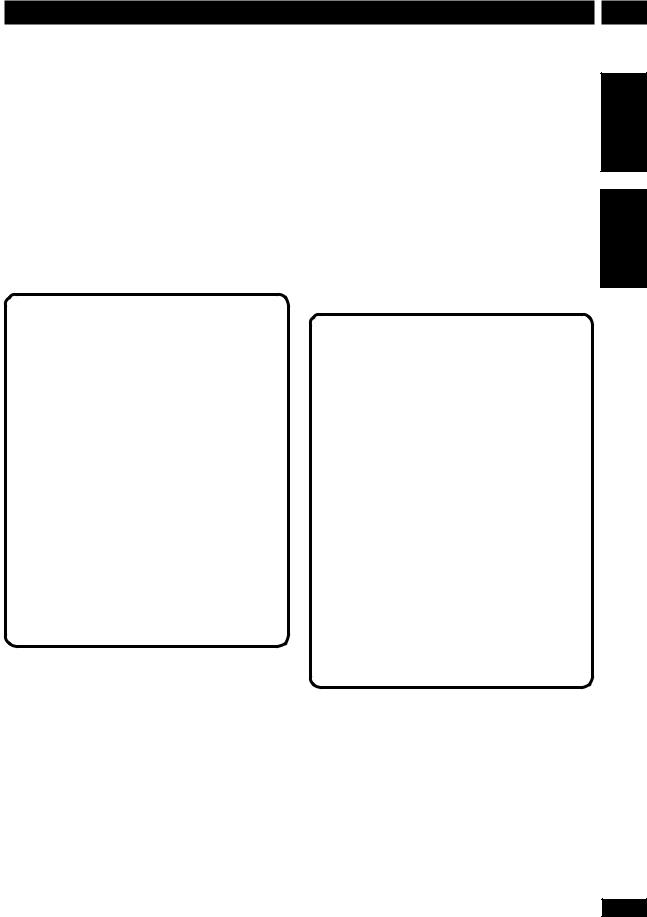
Before You Start |
Préparatifs |
1 |
Features
•Superlative audio performance with Dolby Digital* and DTS** software
The XV–HTD320 delivers breathtaking sound quality with Dolby Digital and DTS discs.
•Graphical Setup Navigator
Setting up your home theater is easy using the graphical Setup Navigator. Answer the questions that appear on-screen and the Setup Navigator makes the necessary video and language settings for you.
• This product incorporates copyright protection technology that is protected by method claims of certain U. S. patents and other intellectual property rights owned by Macrovision Corporation and other rights owners. Use of this copyright protection technology must be authorized by Macrovision Corporation, and is intended for home and other limited viewing uses only unless otherwise authorized by Macrovision Corporation. Reverse engineering or disassembly is prohibited.
*Manufactured under license from Dolby Laboratories. “Dolby”, “Pro Logic” and the double-D symbol are trademarks of Dolby Laboratories.
**“DTS” and “DTS Digital Surround” are registered trademarks of Digital Theater Systems, Inc.
Caractéristiques
•Performance audio supérieure avec Dolby Digital* et logiciel DTS**
Le XV–HTD320 fournit une extraordinaire qualité sonore avec les disques Dolby Digital et DTS.
•Setup Navigator (navigateur de configuration) graphique
Il est facile de régler votre “home theater” en utilisant le Setup Navigator. Répondez aux questions qui apparaissent à l’écran et le Setup Navigator fera les réglages audio, vidéo et de langue pour vous.
• Ce produit intègre une technologie de protection des droits d’auteur elle-même protégée par certains brevets nord-américains et d’autres droits sur la propriété intellectuelle qui appartiennent à la société Macrovision Corporation et à d’autres détenteurs. L’illustration de cette technologie de protection des droits d’auteur doit être autorisée par ladite société Macrovision Corporation et est exclusivement destinée à une exploitation à domicile et à d’autres usages limités, sauf autorisation différente. La recherche technique par inversion ou le désassemblage est interdit.
*Fabriqué sous licence de Dolby Laboratories. “Dolby”, “Pro Logic” et le symbole double-D sont des marques de Dolby Laboratories.
**“DTS” et “DTS Digital Surround” sont des marques commerciales de Digital Theater Systems, Inc.
aisçFran English
7
En/Fr
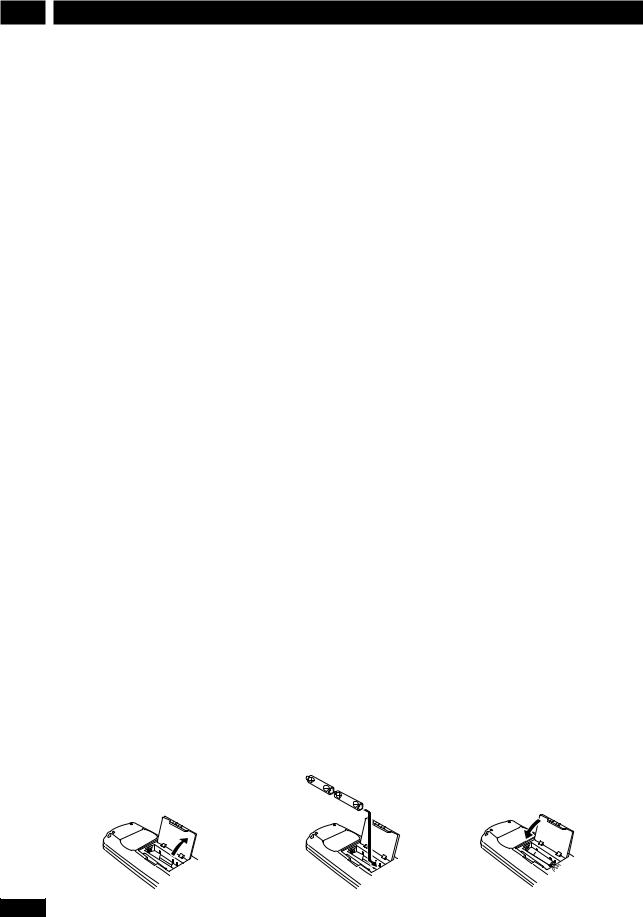
1 Before You Start |
Préparatifs |
What’s in the box
Confirm that the following accessories are in the box when you open it.
•Remote control
•AA/R6P dry cell batteries x2
•AM loop antenna
•FM antenna
•Video cord (yellow)
•Power cord
•These operating instructions
•Warranty card
Contenu de la boîte
Vérifiez que les accessoires suivants se trouvent dans la boîte à son ouverture.
•Télécommande
•2 piles sèches AA/R6P
•Antenne cadre AM
•Antenne FM
•Cordon vidéo (jaune)
•Cordon d’alimentation
•Ce mode d’emploi
•Fiche de garantie
Using this manual
This manual is for the XV–HTD320 DVD Receiver. It is divided into several sections: system basics and connecting up (chapters 1 and 2); an explanation of the controls and displays (chapter 3); setting up for surround sound and other preferences (chapter 4); getting started (chapter 5); advanced features (chapters 6–9); system settings and preferences (chapter 10). Chapter 11 provides additional information, including a glossary of terms used in this manual, and a troubleshooting section.
Putting the batteries in the remote control
1Open the battery compartment cover on the back of the remote control.
2Insert two AA/R6P batteries into the battery compartment following the indications (ª, ·) inside the compartment.
3 Close the cover.
1 |
2 |
8
Utilisation de ce manuel
Ce manuel est consacré au récepteur DVD XV–HTD320. Il est divisé en plusieurs sections : bases et raccordement de l’appareil (chapitres 1 et 2) ; une explication des commandes et des affichages (chapitre 3) ; configuration pour son surround et autres priorités (chapitre 4) ; mise en service (chapitre 5) ; caractéristiques avancées (chapitres 6–9) ; réglages de l’appareil et priorités (chapitre 10). Le chapitre 11 fournit des informations additionnelles, y compris un glossaire de termes utilisés dans ce manuel, et une section guide de dépannage.
Placer les piles dans la télécommande
1Soulevez le couvercle du compartiment à piles qui se trouve au dos de la télécommande.
2Insérez deux piles AA/R6P dans le compartiment à piles en suivant les indications (ª, ·) à l’intérieur du compartiment.
3 Refermez le couvercle.
3
En/Fr

Before You Start |
Préparatifs |
1 |
•Remove the batteries if the remote is not going to be used for a month or more.
•Remove dead batteries promptly—they can leak and damage the unit.
•When disposing of used batteries, please comply with governmental regulations or environmental public institution’s rules that apply in your country or area.
Using the remote control
Keep in mind the following when using the remote control:
•Make sure that there are no obstacles between the remote control and the remote sensor on the unit.
•Use within 7 meters (21 feet) of the remote sensor and at an angle of less than 30º.
•Remote operation may become unreliable if strong sunlight or fluorescent light is shining on the unit’s remote sensor.
•Remote controllers for different devices can interfere with each other. Avoid using remotes for other equipment located nearby this unit.
•Replace the batteries when you notice the operating range of the remote starts to decrease.
Attention
•Enlevez les piles si vous n’utilisez pas la télécommande pendant un mois ou plus.
•Enlevez immédiatement les piles usées—elles peuvent présenter une fuite et endommager l’unité.
•Lorsque vous avez des piles usagées, veuillez respecter les réglementations gourvernementales ou environnementales en vigueur dans votre pays ou dans votre région.
Utilisation de la télécommande
N’oubliez pas les remarques suivantes lorsque vous utilisez la télécommande:
•Vérifiez qu’il n’y a aucun obstacle entre la télécommande et le télécapteur de l’unité.
•Utilisez-la à 7 (21 pieds) mètres du télécapteur et dans un angle inférieur à 30º.
•La commande à distance peut être affectée par un rayonnement solaire important ou si une lumière fluorescente éclaire le télécapteur de l’unité.
•Plusieurs télécommandes peuvent faire interférence. Évitez d’utiliser les télécommandes destinées à d’autres appareils à proximité de l’unité.
•Changez les piles dès que vous remarquez une baisse de la plage d’utilisation de la télécommande.
aisçFran English
Hints on installation
We want you to enjoy using this unit for years to come, so please bear in mind the following points when choosing a suitable location for it:
Do...
Use in a well-ventilated room.
Place on a solid, flat, level surface, such as a table, shelf or stereo rack.
Don’t...
Use in a place exposed to high temperatures or humidity, including near radiators and other heatgenerating appliances.
Place on a window sill or other place where the system will be exposed to direct sunlight.
Suggestions pour l’installation
Nous souhaitons que vous puissiez profiter de cet appareil pendant les années à venir, veuillez donc garder en mémoire les points suivants au moment de choisir un endroit convenable pour son installation :
À faire...
Utilisez-le dans une pièce bien aérée.
Placez-le sur une surface solide, plate, nivelée, telle qu’une table, une étagère ou étagère pour chaîne stéréo.
À ne pas faire...
Ne l’utilisez pas dans un endroit exposé à de hautes températures ou à de l’humidité, y compris près de radiateurs et d’autres appareils générateurs de chaleur.
Ne le placez pas sur le rebord d’une fenêtre ou autre endroit exposé directement aux rayons du soleil.
9
En/Fr

1 Before You Start |
Préparatifs |
Use in an excessively dusty or damp environment.
Place directly on top of an amplifier, or other component in your stereo system that becomes hot in use.
Use near a television or monitor as you may experience interference—especially if the television uses an indoor antenna.
Use in a kitchen or other room where the system may be exposed to smoke or steam.
Use on a thick rug or carpet, or cover with cloth— this may prevent proper cooling of the unit.
Place on an unstable surface, or one that is not large enough to support all four of the unit’s feet.
Avoiding problems with condensation
Condensation may form inside the system if it is brought into a warm room from outside, or if the temperature of the room rises quickly. Although the condensation won’t damage the system, it may temporarily impair its performance. For this reason you should leave it to adjust to the warmer temperature for about an hour before switching on and using.
Moving the system
If you need to move the system, first switch it off and unplug from the wall outlet. Never lift or move the unit during playback—discs rotate at a high speed and may be damaged.
Ne l’utilisez pas dans un environnement excessivement poussiéreux ou humide.
Ne le placez pas directement au-dessus de
l’amplificateur, ou d’un autre composant de votre chaîne stéréo qui se réchauffe à l’utilisation.
Ne l’utilisez pas près d’un téléviseur ou d’un moniteur puisque vous pouvez expérimenter des interférences-spécialement si le téléviseur emploie une antenne intérieure.
Ne l’utilisez pas dans une cuisine ou autre pièce où l’appareil peut être exposé à de la fumée ou de la vapeur.
N’utilisez pas de couverture, ni de tapis épais, ou un linge pour le recouvrir—ceci peut empêcher le refroidissement correct de l’appareil.
Ne le placez pas sur une surface instable, ou pas assez grande pour supporter les quatre pieds de l’appareil.
Comment éviter les problèmes de condensation
De la condensation peut se former à l’intérieur du lecteur si celui-ci est déplacé de l’extérieur à une pièce chaude, ou si la température de la pièce s’élève rapidement. Quoique la condensation n’endommagera pas le lecteur, elle peut diminuer temporairement son fonctionnement normal. Dans ce cas vous devriez le laisser tel quel pendant environ une heure afin qu’il s’adapte à la plus chaude température avant de l’allumer et de l’utiliser.
Déplacer l’appareil
Si vous avez besoin de déplacer l’appareil, éteignez-le d’abord et débranchez-le de la prise. Ne soulevez ni déplacez jamais l’appareil pendant la lecture—les disques tournent à une haute vitesse et ils pourraient s’endommager.
10
En/Fr
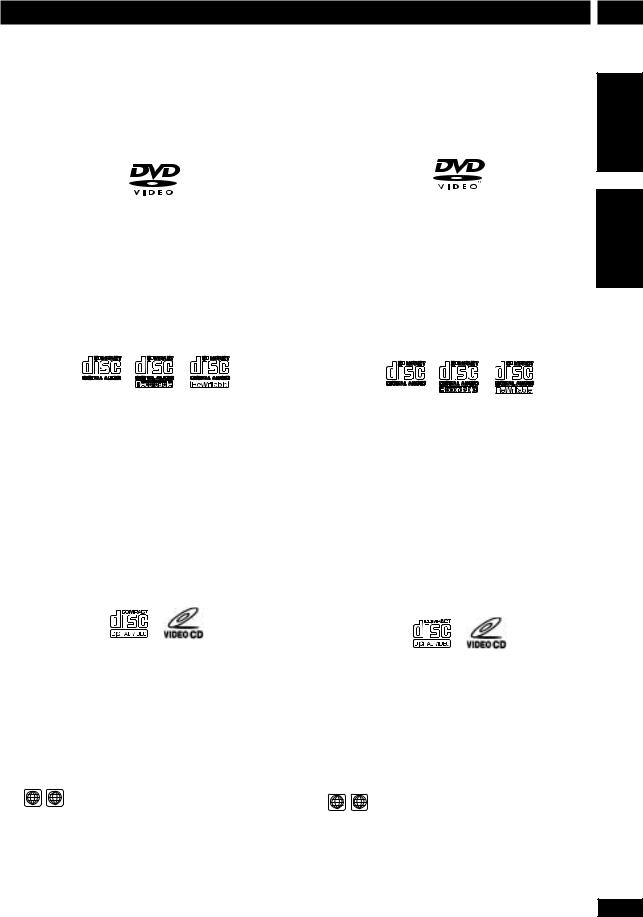
Before You Start |
Préparatifs |
1 |
Discs compatible with this system
Any disc that displays one of the following logos should play in this system. Other formats, including DVD-RAM, DVD-ROM, DVD-Audio, CD-ROM, SACD and Photo CD will not play.
DVD Video compatibility:
•Single-sided or double-sided discs
•Single layer or dual layer discs
•Dolby Digital, DTS, MPEG or Linear PCM digital audio
•MPEG-2 digital video
DVD discs are generally divided into one or more titles. Titles may be further subdivided into chapters.
Disques compatibles avec cet appareil
Cet appareil devrait pouvoir lire les disques portant les logos suivants. Il se peut qu’il ne lise pas d’autres formats, y compris les DVD-RAM, DVD-ROM, DVD Audio, CD-ROM, SACD et les Photo CD.
Compatibilité des DVD vidéo :
•Disques à face simple ou double face.
•Disques à couche simple ou double couche.
•Dolby Digital, DTS, MPEG ou audio numérique Linear PCM.
•Vidéo numérique MPEG-2.
En général, les disques sont divisés en un ou plusieurs titres. À leur tour les titres sont sous-divisés en chapitres.
aisçFran English
Audio CD compatibility:
•12cm or 8cm (5” or 3”) discs
•Linear PCM digital audio
•CD-Audio, CD-R* and CD-RW* formats CDs are divided into tracks.
* This system can play CD-R and CD-RW discs recorded with audio. However, depending on the condition of the player and the disc, you may find that not all discs will play successfully. (For example, if the disc is scratched or dirty, or if the player’s pickup lens is dirty.) Note that this unit cannot record onto recordable discs.
Compatibilité des CD audio :
•Disques de 12 cm ou 8 cm.
•Audio numérique Linear PCM.
•Formats CD-Audio, CD-R* et CD-RW* Les disques sont divisés en pistes.
* Cet appareil peut lire des disques CD-R et CD-RW enregistrés avec audio. Mais dépendant de la condition du lecteur et du disque, il se peut que la lecture de tous les disques ne se fasse pas avec succès. (Par exemple, si le disque est rayé ou sale, ou si la lentille du capteur du lecteur est sale.) Remarquez que cette unité ne peut pas enregistrer sur des disques enregistrables.
Video CD compatibility:
•12cm or 8cm (5” or 3”) discs
•MPEG-1 digital audio
•MPEG-1 digital video
Video CDs are divided into tracks.
DVD Video regions
1 ALL
All DVD Video discs carry a region mark on the case somewhere that indicates which region(s) of the world the disc is compatible with. Your DVD system also has a region mark, which you can find on the rear panel. Discs from incompatible regions will not play in this system. Discs marked ALL will play in any player.
Compatibilité des Video CD :
•Disques de 12 cm ou 8 cm.
•Audio numérique MPEG-1.
•Vidéo numérique MPEG-1. Les disques sont divisés en pistes.
Régions des DVD vidéo
1 ALL |
|
Tous les disques DVD vidéo portent une marque de la |
|
région sur l’étui pour indiquer avec quelles régions du |
|
monde le disque est compatible. Votre chaîne DVD a |
|
également une marque que vous pouvez trouver sur le |
|
panneau arrière. Les disques provenant de régions |
|
incompatibles ne seront pas lus sur cet appareil. Les disques |
11 |
marqués avec ALL seront lus sur qu’importe quel lecteur. |
En/Fr
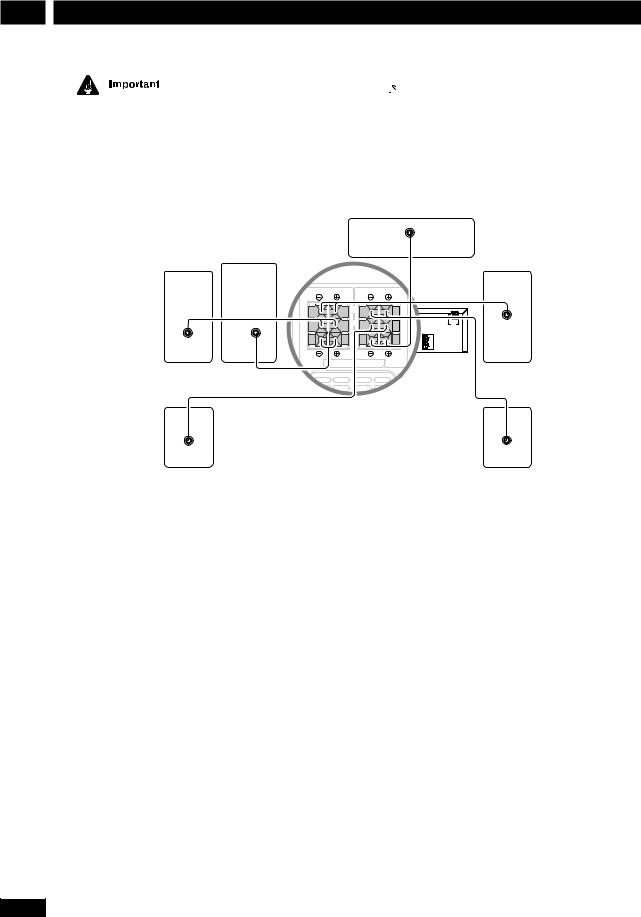
2 Connecting Up |
Raccordements |
Before making or changing any rear panel connections, make sure that all the components are switched off and unplugged from the power supply.
 Important
Important
Avant de faire ou de changer des raccordements sur le panneau arrière, vérifiez que tous les composants sont éteints et débranchés.
Connecting the speakers |
Raccordement des enceintes |
|
Center |
|
Centrale |
Subwoofer |
|
Enceinte d’extrêmes graves |
|
FRONT |
REAR |
L |
L |
L |
R |
R |
R |
|
SPEAKERS |
|
|
|
1 |
SUB-
WOOFER SPEAKERS CENTER
Front R
Frontale R
AC INLET
H |

 H
H
Front L
Frontale L
Rear R |
Rear L |
Arrière R |
Arrière L |
The speaker terminal tabs and speaker cables are colorcoded for simpler connection.
1Connect the front speakers to the FRONT L and FRONT R terminals with the attached speaker cables (red sleeves).
2Connect the rear speakers to the REAR L and REAR R terminals using the attached speaker cables (blue sleeves).
3Connect the subwoofer to the SUBWOOFER terminals using the attached speaker cable (grey sleeves).
4Connect the center speaker to the CENTER terminals using the
attached speaker cable (green sleeves).
For proper sound, it’s important to connect the positive (colored) and negative (black) terminals for each speaker correctly.
12
Les languettes des bornes d’enceinte et les câbles d’enceinte sont codés par couleur pour un raccordement plus simple.
1Raccordez les enceintes avant aux bornes FRONT L et FRONT R avec les câbles d’enceinte qui sont joints (manchons rouges).
2Raccordez les enceintes arrière aux bornes REAR L et REAR R en utilisant les câbles d’enceinte qui sont joints (manchons bleus).
3Raccordez l’enceinte d’extrêmes graves aux bornes SUBWOOFER en utilisant le câble d’enceinte qui est joint (manchons gris).
4Raccordez l’enceinte centrale aux bornes CENTER en utilisant le câble d’enceinte qui est joint (manchons verts).
Pour obtenir un son approprié, il est important de raccorder correctement les bornes positives (de couleur) et les bornes négatives (noires) pour chaque enceinte.
En/Fr
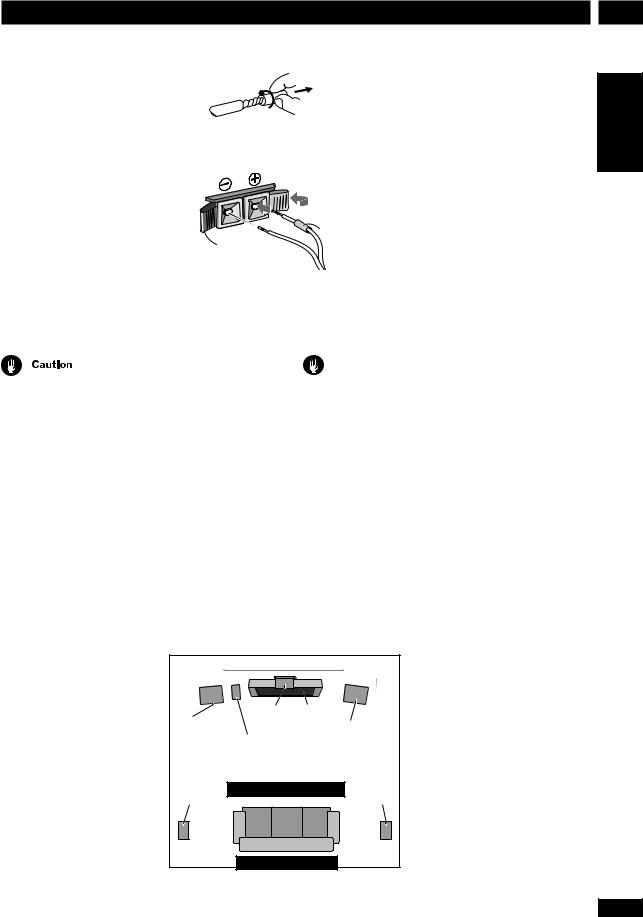
 Black tab Languette noire
Black tab Languette noire
Raccordements |
2 |
1 Détressez les couvertures
|
protectrices aux |
English |
|
|
|
||
|
extrémités du câble |
|
|
|
d’enceinte. |
|
|
Colored tab |
2 Pressez les languettes de |
|
|
la borne d’enceinte pour |
|
||
Languette de couleur |
|
||
|
ouvrir et insérer le fil au |
Français |
|
Colored |
manchon coloré dans la |
||
|
|||
sleeve |
borne colorée et l’autre |
|
|
M a n c h o n |
|
||
fil dans la borne noire. |
|
||
de couleur |
|
||
|
3 Relâchez les languettes de |
|
|
|
la borne d’enceinte pour |
|
|
|
fixer le câble d’enceinte. |
|
Attention
Ne raccordez aucune des enceintes à aucun autre amplificateur. Ceci pourrait provoquer un mauvais fonctionnement ou un incendie.
Ce récepteur DVD a été conçu pour offrir la meilleure performance au raccordement des enceintes fournies. Nous vous recommandons, toutefois, de ne pas raccorder et utiliser d’autres enceintes avec cet appareil.
Placer les enceintes
L’endroit de la pièce où vous placerez vos enceintes aura un effet important sur la qualité sonore. Le guide suivant peut vous aider à obtenir le meilleur son possible de votre appareil.
• Vous pouvez placer l’enceinte d’extrêmes graves par terre. Dans l’idéal, les autres enceintes devraient se trouver environ au niveau des oreilles au moment zzde l’écoute. Il n’est pas recommandé de mettre les enceintes par terre (sauf l’enceinte d’extrêmes graves ),
ou de les monter trop haut au mur.
•Pour obtenir un meilleur effet stéréo, placez les enceintes avant à une distance de 2–3 mètres (6–9 pieds) entre elles.
•Les enceintes arrière ne devraient pas se
trouver aussi loin de votre position d’écoute que les enceintes avant.
• L’enceinte centrale devrait se trouver le plus près possible de l’écran du téléviseur afin que les dialogues du film soient localisés correctement.
13
En/Fr
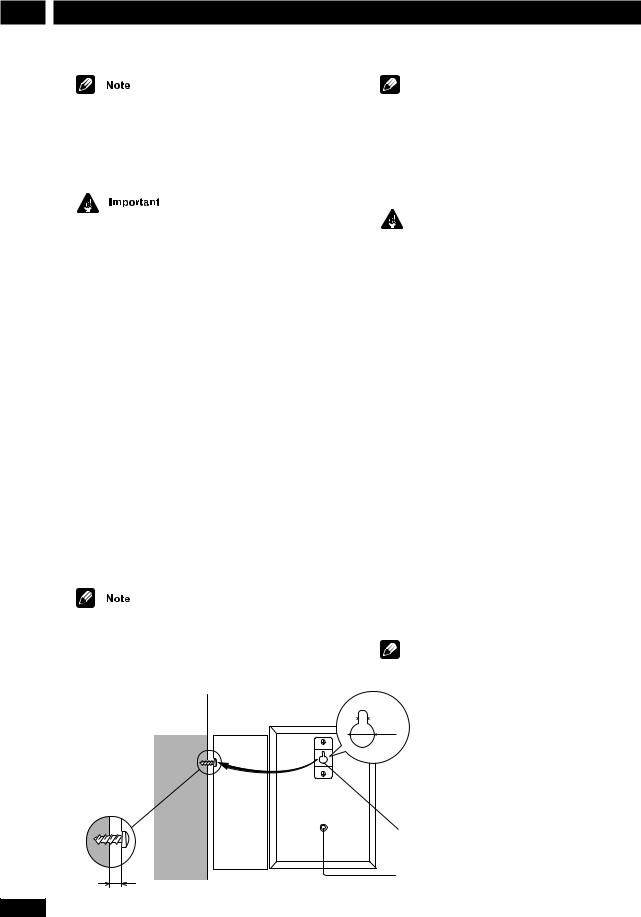
2
14
Connecting Up
If you install the center speaker on top of your TV, be sure to secure it with tape or by some other suitable means. An unsecured speaker may fall from the TV due to external shocks such as earthquakes, endangering those nearby or damaging the speaker.
The front and center speakers supplied with this system are magnetically shielded. However, placing them extremely close to a television may result in color distortion on the screen. If this happens, move the speakers a little further away and switch off the television for 15–30 minutes.
The rear speakers and subwoofer are not magnetically shielded, so they should not be placed near a TV or monitor.
Wall mounting the rear speaker system
Before mounting
• Remember that this speaker system is heavy and that its weight may cause the wood screw to work loose or the wall to fail to support it, in which case the speaker system may fall on the floor. This is extremely dangerous. Make absolutely sure that the wall is sturdy enough to support the weight of the speaker system. Do not mount it on plywood boards or soft-surface walls. The mounting screws are not included with this unit. Please find the correct screws for your application.
•If you are unsure of the qualities and strength of the walls, consult a professional for advice.
•PIONEER is not responsible for any accidents or damage that result from improper installation.
Wood screw
Vis pour surface en bois
Protrude:5-7mm
Doit dépasser : 5-7 mm
Raccordements
Remarque
Si vous installez l’enceinte centrale au-dessus de votre téléviseur, vérifiez de bien la fixer avec une bande ou quelqu’autre moyen convenable. Une enceinte mal fixée peut tomber du téléviseur dû à des chocs externes tels que des tremblements de terre, mettre ainsi en danger ce qui est près ou endommanger l’enceinte.
Important
Les enceintes avant et centrale fournies avec cet appareil ont un revêtement magnétique. Cependant, les placer extrêment près d’un téléviseur peut entraîner une déformation de la couleur de l’écran. Si cela se produisait, éloignez un peu les enceintes et éteignez le téléviseur pendant 15–30 minutes.
Les enceintes arrière et l’enceinte d’extrêmes graves n’ont pas de revêtement magnétique, il ne faudrait donc pas les placer près d’un téléviseur ou d’un moniteur.
Monter au mur le système acoustique arrière
Avant la montage
• N’oubliez pas que ce système acoustique est lourd et que par son poids la vis pour surface en bois peut se détacher ou le mur peut ne pas le supporter, auquel cas le système acoustique pourrait tomber par terre. Ceci est extrêmement dangereux. Veuillez vous assurer complètement que le mur est assez résistant pour supporter le système acoustique. Ne le montez pas sur des panneaux en contre-plaqué ou des murs à surface souple. Les vis de montage ne sont pas comprises avec l’appareil. Veuillez vous procurez les vis appropriées pour cette occasion.
Remarque
• Si vous n’êtes pas sûr de la qualité et de la solidité des murs, veuillez demander conseil à
un professionnel.
3.5 mm
|
|
• PIONEER décline toute |
|
9.5 mm |
|||
responsabilité résultant de tout accident |
|||
|
|
||
|
|
ou dommage causé par une installation |
|
|
|
incorrecte. |
|
Wall-mounting bracket
Crochet de montage au mur.
En/Fr
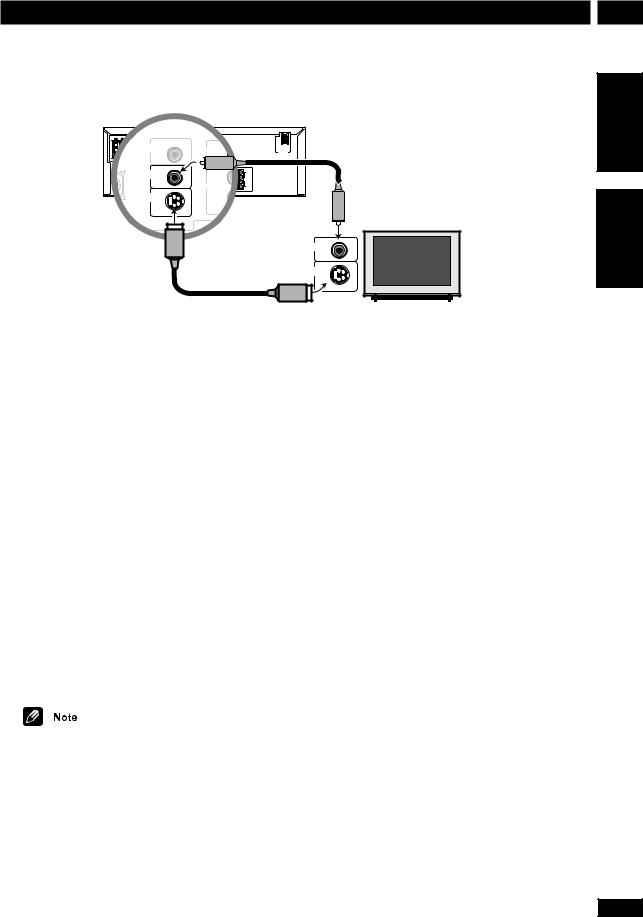
Connecting Up |
Raccordements |
2 |
Connecting to your TV |
Raccordement à votre téléviseur |
DIGITAL |
COAX |
R |
IN |
TV/ |
AC INLET |
|
VCR |
VOLTAGE |
|
IN |
SELECTOR |
|
|
|
|
240V |
|
|
|
|
|
220- |
|
|
OUT |
IN |
|
230V |
Supplied video cord |
|
ANTENNA |
110- |
|||
|
VIDEO |
|
H |
|
|
|
|
AM |
127V |
|
|
|
|
|
LOOP |
|
|
1 |
|
|
FM |
|
|
|
|
UNBAL |
|
|
|
AUX |
|
75Ω |
|
Cordon vidéo fourni |
|
|
H |
|
|||
|
S-VIDEO |
OUT |
|
|
|
|
OUT |
|
|
|
VIDEO
IN
S-VIDEO
IN
S-Video cord (not supplied)
Cordon S-Video (non fourni)
aisçFran English
1Use the supplied yellow video cord to connect the VIDEO OUT jack to a video input on your TV.
Alternatively, you can use an S-Video cable (not supplied) to connect the S-VIDEO OUT jack to an S- Video input on your TV. S-Video should give you better picture quality than using the standard VIDEO OUT.
• See S-Video Out on page 58 for how to change the S-Video setting between S1 and S2 format.
2Optionally: Use a stereo audio cord to connect the audio out jacks of your TV (or VCR) to the TV/VCR IN jacks.
This will enable you to hear the TV (or VCR) sound through this system.
• If you want to connect both your TV and VCR, use the TV/VCR IN jacks for one and the AUX IN jacks for the other.
Placing the main unit too close to your TV may cause interference, especially if you’re using an indoor antenna. If you notice interference, move the unit away from the TV.
1Utilisez le cordon vidéo jaune fourni pour raccorder la prise VIDEO OUT à une sortie vidéo sur votre téléviseur.
Alternativement, vous pouvez utiliser un câble S-Video (non fourni) pour raccorder la prise S-VIDEO OUT à une entrée S-Video sur votre téléviseur. S-Video devrait
fournir une meilleure qualité d’image qu’en utilisant
VIDEO OUT.
• Voir Sortie S-Video à la page 58 pour modifier le réglage S-Video entre le format S1 et S2.
2En option: Utilisez un cordon audio stéréo pour raccorder les prises de sortie audio de votre téléviseur (ou de votre magnétoscope) aux prises TV/VCR IN.
Cela vous permettra d’entendre le son du téléviseur (ou du magnétoscope) à travers cet appareil.
• Si vous souhaitez raccorder votre téléviseur et votre magnétoscope, utilisez les prises TV/VCR IN pour l’un et les prises AUX IN pour l’autre.
 Remarque
Remarque
Si vous placez l’unité principale trop près de votre téléviseur cela peut provoquer des interférences, en particulier si vous utilisez une antenne intérieure. Si vous remarquez des interférences, éloignez l’unite du téléviseur.
15
En/Fr
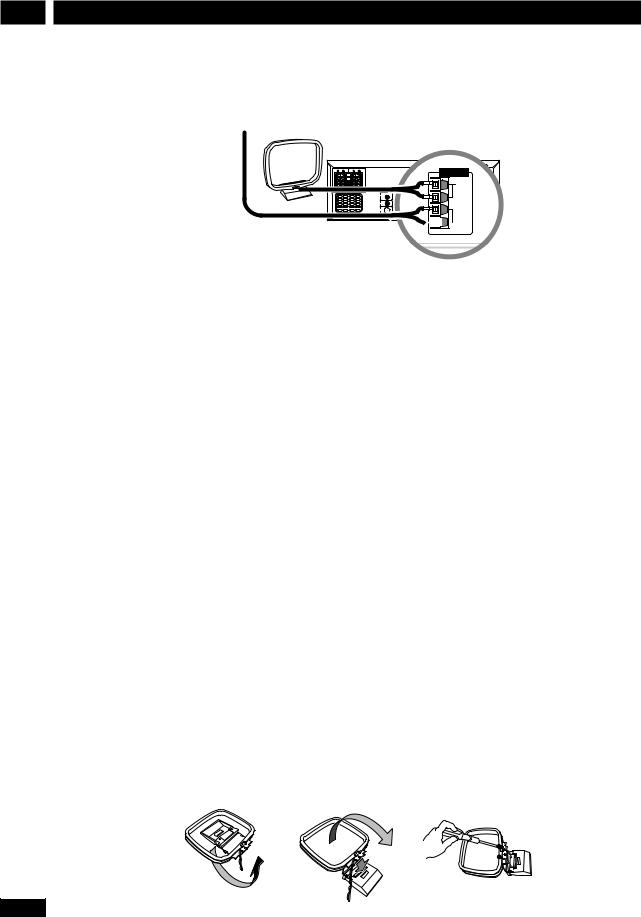
2
16
Connecting Up |
Raccordements |
Connecting the supplied antennas |
Raccordement des antennes |
FM wire antenna |
fournies |
Fil d’antenne FM |
AM loop antenna |
|
|
|
Antenne cadre AM |
|
ANTENNA |
|
H |
SPEAKERS |
AM |
|
LOOP |
|
ANTENNA |
FM
UNBAL
75Ω





 H
H
The supplied antennas provide a simple way to listen to AM and FM radio. If you find that reception quality is poor, an outdoor antenna should give you better sound quality—see Connecting external antennas below for more on how to do this.
Les antennes fournies fournissent un moyen simple d’écouter la radio AM et FM. Si vous trouvez que la qualité de la réception est pauvre, une antenne extérieure rne devrait offrir une meilleure qualité sonore—voir Raccordement d’antennes externes cidessous pour plus de détails.
AM loop antenna
1Pull off the protective shields of both AM antenna wires.
2Press the antenna terminal tabs to open and insert one wire into each terminal.
3Release the tabs to secure the AM antenna wires.
4Bend the stand in the direction indicated by the arrow (see fig. A below).
5 Clip the loop onto the stand (fig. B).
6Place the AM antenna on a flat surface and point in the direction giving the best reception.
Avoid placing near computers, television sets or other electrical appliances and do not let it come into contact with metal objects.
Antenne cadre AM
1Retirez les protections des deux fils de l’antenne AM.
2Pressez les languettes des bornes d’antenne pour ouvrir et insérez un fil dans chaque borne.
3Relâchez les languettes pour fixer les fils de l’antenne AM.
4Courbez le support dans le sens indiqué par la flèche (voir fig. A ci-dessous).
5 Accrochez le cadre au support (fig. B).
6Placez l’antenne AM sur une surface plate et pointez-la dans la direction offrant la meilleure réception.
Évitez de la placer près d’ordinateurs, de postes de télévision ou d’autres appareils électriques et ne la laissez pas entrer en contact avec des objets métalliques.
fig. A |
fig. B |
fig. C |
En/Fr
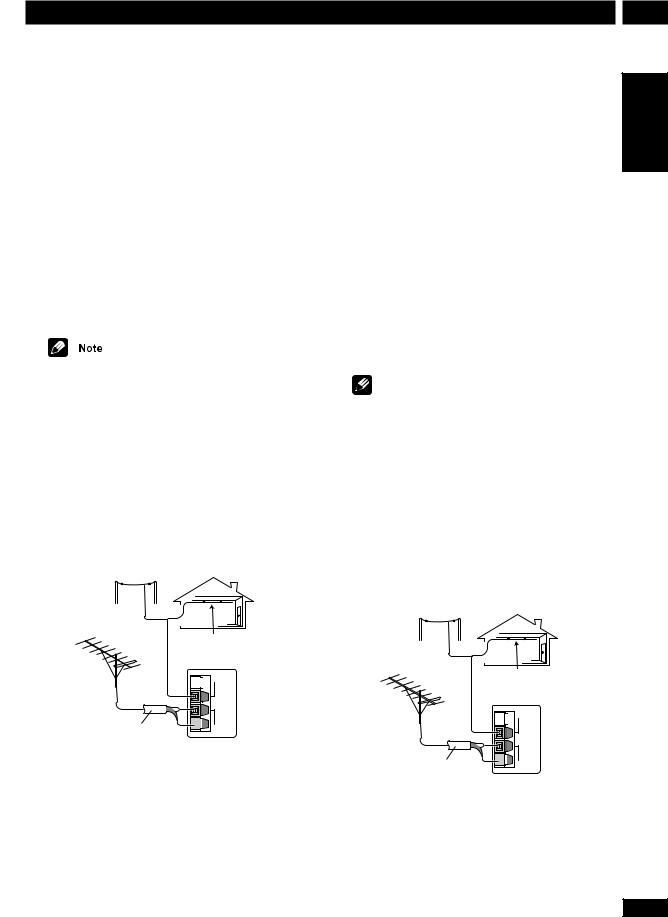
Connecting Up
It’s also possible to fix the AM antenna to a wall. When installing on a wall or other surface, perform steps 4 and 5 after first securing the stand with screws (see fig. C below left). Before fixing, make sure that the reception is satisfactory.
FM wire antenna
•Connect the FM wire antenna to the FM UNBAL 75Ω terminals in the same way as
the AM loop antenna.
For best results, extend the FM antenna fully and fix to a wall or door frame. Don’t drape loosely or leave coiled up.
The signal earth (H) is designed to reduce noise that occurs when an antenna is connected. It is not an electrical safety earth.
Connecting external antennas
External AM antenna
Use 5–6 meters (15–18 ft.) of vinyl-insulated wire and set up either indoors or outdoors. Leave the supplied AM loop antenna connected.
Outdoor
AM antenna
Indoor
AM antenna




 H
H
AM
LOOP
ANTENNA
FM
UNBAL 75Ω



 H
H
75 Ω coaxial cable
External FM antenna
Use 75Ω coaxial cable to hook up an external FM antenna. Do not leave the supplied FM wire antenna attached.
Raccordements |
2 |
Il est également possible de fixer l’antenne AM au mur.
Pour l’installer au mur ou à une autre surface, exécutez |
English |
||
|
|||
les étapes 4 et 5 après avoir fixé fermement d’abord le |
|
||
support avec des vis (voir fig. C ci-dessous à gauche). |
|
||
Avant de la fixer, vérifiez que la réception est |
|
||
satisfaisante. |
|
|
|
|
|
||
|
|
|
|
Fil d’antenne FM |
çFran |
||
|
|||
• Raccordez le fil d’antenne FM aux bornes |
ais |
||
FM UNBAL 75Ω |
de la même manière que |
||
|
|||
pour l’antenne cadre AM. |
|
||
Pour obtenir de meilleurs résultats, étendez |
|
||
complètement l’antenne FM et fixez-la au mur ou à |
|
||
l’encadrement de la porte. Ne la laissez pas relâchée ou |
|
||
enroulée. |
|
|
|
Remarque
Le signe (H) de mise à la masse est conçu pour réduire les parasites qui se produisent au raccordement d’une antenne. Il ne s’agit pas d’une mesure de sécurité.
Raccordement d’antennes externes
Antenne AM externe
Utilisez 5–6 mètres (15–18 pouces) de fil vinyle isolant et installez-le à l’intérieur ou à l’extérieur. Laissez l’antenne cadre AM fournie raccordée.
AntenneOutdoorAM extérieureAM antenna
AntenneI door AM
AM antenna intérieure




 H
H
AM
LOOP
ANTENNA
FM
UNBAL 75Ω



 H
H
Câble coaxial 75 Ω
Antenne FM externe
Utilisez du câble coaxial 75Ω pour raccorder une antenne FM externe. Ne laissez pas attaché le fil d’antenne FM fourni.
17
En/Fr
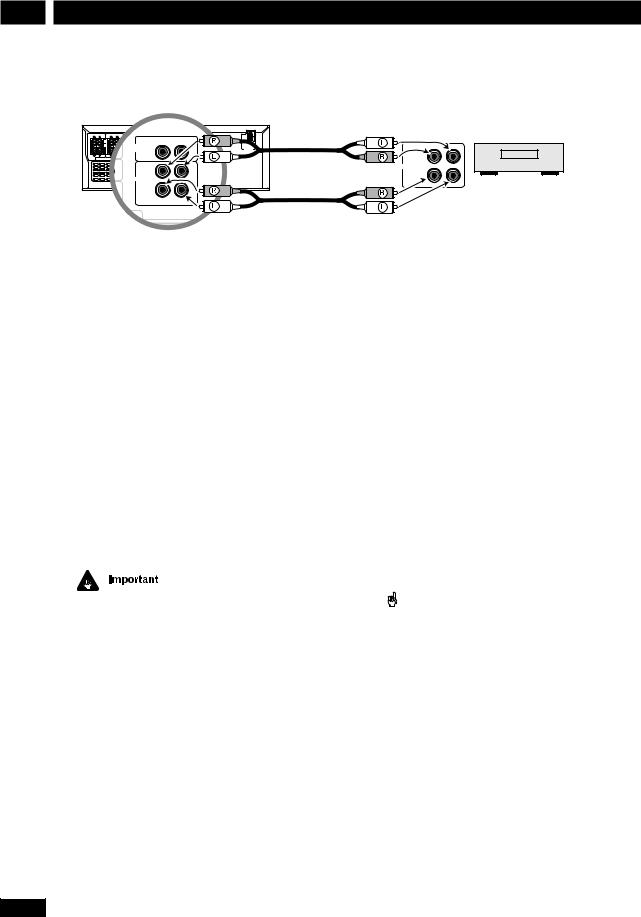
2 Connecting Up |
Raccordements |
Connecting other components |
Raccordement d’autres composants |
FRONT |
|
REAR |
|
|
|
|
|
OAX |
|
|
R |
L |
|
L |
L |
L |
|
|
||
R |
R |
R |
TV/ |
|
|
|
|
|
|
VCR |
IN |
|
|
|
|
|
|
|
|
|
SUB- |
SPEAKERS |
CENTER |
|
|
|
|
WOOFER |
|
|
|
|
||
|
|
|
DIGITAL |
COAX |
R |
L |
|
|
|
IN |
|
|
|
|
|
|
|
IN |
|
H |
|
|
|
OUT |
|
|
|
|
|
|
VIDEO |
|
|
|
|
|
|
1 |
|
|
H |
|
|
|
AUX |
|
|
|
|
|
|
VIDEO |
|
|
Ω |
|
|
|
S-OUT |
|
OUT |
|
OUT
AC INLET |
|
VOLTAGE |
|
SELECTOR |
OUT (PLAY) |
240V |
|
220- |
|
230V |
Analog |
127V |
|
110- |
|
IN (REC)
Tape deck, VCR, MD recorder, etc.
Platine cassette, magnétoscope, enregistreur MD, etc.
1Use a stereo audio cable to connect the AUX IN jacks to the analog outputs of an external component.
This will allow you to play the component through this system.
2Use a stereo audio cable to connect the AUX OUT jacks to the analog inputs of an external component.
This will allow you to record from this system to an external tape/MD/CD recorder.
1Utilisez un câble audio stéréo pour raccorder les prises AUX IN aux sorties analogiques d’un composant externe.
Cela vous permettra de lire le composant à travers cet appareil.
2Utilisez un câble audio stéréo pour raccorder les prises AUX OUT aux entrées analogiques d’un composant externe.
Cela vous permettra d’enregistrer depuis cet appareil à un enregistreur cassette/MD/CD externe.
3Use a digital coaxial cable to connect the DIGITAL IN COAX jack to the digital output of an external component.
This will allow you to play a digital audio component (MD player, etc.) through this system.
The DIGITAL IN COAX jack should only be connected to a PCM audio output (32, 44.1 or 48kHz). These include CD, MD and DAT players and satellite receivers. Check the instructions that came with your other component for more details.
3Utilisez un câble coaxial numérique pour raccorder la prise DIGITAL IN COAX à la sortie numérique d’un composant externe.
Cela vous permettra de lire un composant audio numérique (lecteur MD, etc.) à travers cet appareil.
 Important
Important
Il faudrait raccorder uniquement la prise DIGITAL IN COAX à une sortie audio PCM (32, 44.1 ou 48kHz). Ceci inclut des lecteurs CD, MD et DAT et des récepteurs satellites. Vérifiez les instructions qui accompagnent l’autre composant pour les détails.
Connecting the power
Before connecting the power and switching on for the first time make sure that everything is connected properly.
1Plug one end of the supplied power cord into the AC INLET.
2Plug the other end into a household power outlet.
18
Raccordement secteur
Avant de faire le raccordement secteur et d’allumer pour la première fois vérifiez que tout soit raccordé correctement.
1Branchez une des extrémités du cordon d’alimentation fourni à l’AC INLET.
2Branchez l’autre extrémité à une prise d’alimentation secteur.
En/Fr

Controls & Displays |
Commandes et affichages |
3 |
Front panel |
Panneau avant |
|
|
1 |
|
2 |
|
|
|
|
|
3 |
|
|
4 |
5 |
|
6 |
|
|
|
|
|
|
|
|
|
|
|
|
|
DISC SKIP EXCHANGE |
0 OPEN/CLOSE |
||
|
|
|
|
|
|
|
1 |
2 |
3 |
|
4 |
5 |
|
|
|
|
|
|
|
|
|
|
VIDEO |
|
|
|
|
|
|
|
|
|
|
|
|
|
|
|
|
|
|
|
|
|
|
|
|
|
|
VOLUME |
DVD RECEIVER XV-HTD320 |
|
|
|
|
|
|
|
|
|
|
|
|
|
|
||
STANDBY/ON |
|
|
|
|
|
|
|
|
|
|
|
|
|
|
|
|
STANDBY |
CD |
ADVANCED |
|
|
|
|
|
DISC |
1 |
2 |
3 |
4 |
5 |
|
|
|
|
MODE |
THEATER |
|
|
|
|
|
|
|
|
|
|
|
|
|
|
1 |
|
|
|
|
|
|
|
|
|
|
|
|
|
|
|
|
|
DVD/CD |
TUNER/BAND |
TV/AUX |
CD MODE |
7 |
3/8 |
4.1 |
|
¡.¢ |
|
|
|
|
|
||
|
|
|
|
|
|
|
|
|
|
|
|
|
|
|
|
PHONES |
18 |
17 |
16 |
15 |
14 |
13 |
12 |
11 |
|
10 |
|
9 |
|
8 |
7 |
||
Français English
1 |
STANDBY indicator |
1 |
Indicateur STANDBY |
|
CD MODE indicator |
|
Indicateur CD MODE |
|
ADVANCED THEATER indicator |
|
Indicateur ADVANCED THEATER |
2 |
Disc tray |
2 |
Plateau à disque |
3 |
Disc buttons Page 30 |
3 |
Touches des disques Page 30 |
4 |
DISC SKIP Pages 29-31 |
4 |
DISC SKIP Pages 29-31 |
5 |
EXCHANGE Pages 31, 33 |
5 |
EXCHANGE Pages 31, 33 |
6 |
0OPEN/CLOSE Pages 29, 31 |
6 |
0OPEN/CLOSE Pages 29, 31 |
7 |
PHONES Plug in a pair of headphones here. |
7 |
PHONES Branchez ici une paire d’écouteurs. |
8 |
VOLUME Turn to adjust the volume. |
8 |
VOLUME Tournez-le pour régler le volume. |
9 |
DISC indicators |
9 |
Indicateurs DISC |
10 |
¡• ¢ Pages 30, 32 |
10 |
¡• ¢ Pages 30, 32 |
11 |
4• 1 Pages 30, 32 |
11 |
4• 1 Pages 30, 32 |
12 |
6 Page 30 |
12 |
6 Page 30 |
13 |
7 Page 30 |
13 |
7 Page 30 |
14 |
CD MODE Page 47 |
14 |
CD MODE Page 47 |
15 |
TV/AUX (/DIGITAL IN) Pages 35, 51 |
15 |
TV/AUX (/DIGITAL IN) Pages 35, 51 |
16 |
TUNER/BAND Pages 33, 35, 51 |
16 |
TUNER/BAND Pages 33, 35, 51 |
17 |
DVD/CD Pages 29, 51 |
17 |
DVD/CD Pages 29, 51 |
18 |
STANDBY/ON Page 29 |
18 |
STANDBY/ON Page 29 |
19
En/Fr

3 Controls & Displays
Remote control
DVD |
TUNER |
TV |
STANDBY |
|
|
|
|
/CD |
/BAND |
/AUX |
/ON |
|
|
|
|
|
|
|
|
1 |
2 |
3 |
4 |
MUTE |
TEST TONE SURROUND |
|
|
|
|
|
|
CH LEVEL |
MODE |
|
|
|
|
|
|
|
|
|
|
5 |
6 |
7 |
|
– |
VOLUME |
+ |
8 |
|
|
9 |
|
DVD SETUP |
|
|
SYSTEM SETUP |
|
|
|
|
|
5 |
|
10 |
11 |
|
12 |
|
|
|
|
|
|
|||
2 ENTER |
3 |
13 |
14 |
|
15 |
||
TOP MENU |
∞ |
|
16 |
17 |
|
18 |
|
MENU |
SOUND |
|
|||||
|
|
|
RETURN |
19 |
20 |
|
21 |
7 |
6 |
|
|
||||
– PREV eSTEP/SLOW E |
NEXT + |
22 |
23 |
24 |
25 |
||
4 |
1 |
¡ |
¢ |
||||
CONDITION |
LAST MEMO |
SEARCH |
DVD DISP |
|
|
|
|
1 |
2 |
3 |
CLEAR |
26 |
27 |
28 |
29 |
ANGLE |
MONO |
SLEEP |
FL DIMMER |
|
|
|
|
4 |
5 |
6 |
>10 |
30 |
31 |
32 |
33 |
PROGRAM |
RANDOM |
REPEAT |
REP A–B |
|
|
|
|
7 |
8 |
9 |
10/0 |
34 |
35 |
36 |
37 |
|
|
|
|
||||
CD MODE |
AUDIO |
SUBTITLE |
SYSTEM DISP |
|
|
|
|
|
|
|
|
38 |
39 |
40 |
41 |
DISC 1 |
DISC 2 |
DISC 3 |
DISC SKIP |
|
|
|
|
|
|
|
|
42 |
43 |
44 |
45 |
SHIFT |
DISC 4 |
DISC 5 |
OPEN/ |
|
|
|
|
CLOSE |
46 |
47 |
48 |
49 |
|||
|
|
|
0 |
||||
1DVD/CD Pages 29, 51
2 TUNER/BAND Pages 33, 35, 51
3 TV/AUX Pages 35, 51
4STANDBY/ON Page 29
5 MUTE Silences/restores all sound.
6 TEST TONE/CH LEVEL Page 26
7 SURROUND MODE Pages 25, 38
8 VOLUME – Lowers the volume.
9 VOLUME + Raises the volume.
10DVD SETUP Pages 27, 57
11Cursor up Use for navigating menus and on-screen displays.
12SYSTEM SETUP Pages 23-24, 35, 52, 54-55
13Cursor left Use for navigating menus and on-screen displays.
14ENTER
15Cursor right Use for navigating menus and on-screen displays.
16MENU Page 32
20
TOP MENU Page 32
17Cursor down Use for navigating menus and on-screen displays.
18SOUND Pages 39-40
197 Page 30
203/8Page 30
21RETURN  Page 32
Page 32
224 / –PREV Pages 30, 32
231/ STEP/SLOW ePages 30-31
24¡/ STEP/SLOW EPages 30-31
25¢ / NEXT+ Pages 30, 32
261 / CONDITION (SHIFT & 1) Page 49
272 / LAST MEMO (SHIFT & 2) Page 48-49
283 / SEARCH (SHIFT & 3) Page 41
29CLEAR Clears/cancels various functions
DVD DISP (SHIFT & CLEAR) Page 50
304 / ANGLE (SHIFT & 4) Page 42
315 / MONO (SHIFT & 5) Page 34
326 / SLEEP (SHIFT & 6) Page 53
33>10 Selects numbers over 10 Page 30
FL DIMMER (SHIFT & >10) Page 68
347 / PROGRAM (SHIFT & 7) Page 45
358 / RANDOM (SHIFT & 8) Page 46
369 / REPEAT (SHIFT & 9) Pages 46-47
37REP A–B (SHIFT & 10/0) Page 47
10/0 Number button (10 and 0)
38CD MODE Page 47
39AUDIO Pages 42-43
40SUBTITLE Page 42
41SYSTEM DISP Page 23
42DISC 1 Page 30
43DISC 2 Page 30
44DISC 3 Page 30
45DISC SKIP Pages 29-31
46SHIFT Hold down to access secondary button functions
47DISC 4 Page 30
48DISC 5 Page 30
49OPEN/CLOSE 0Pages 29, 31
En
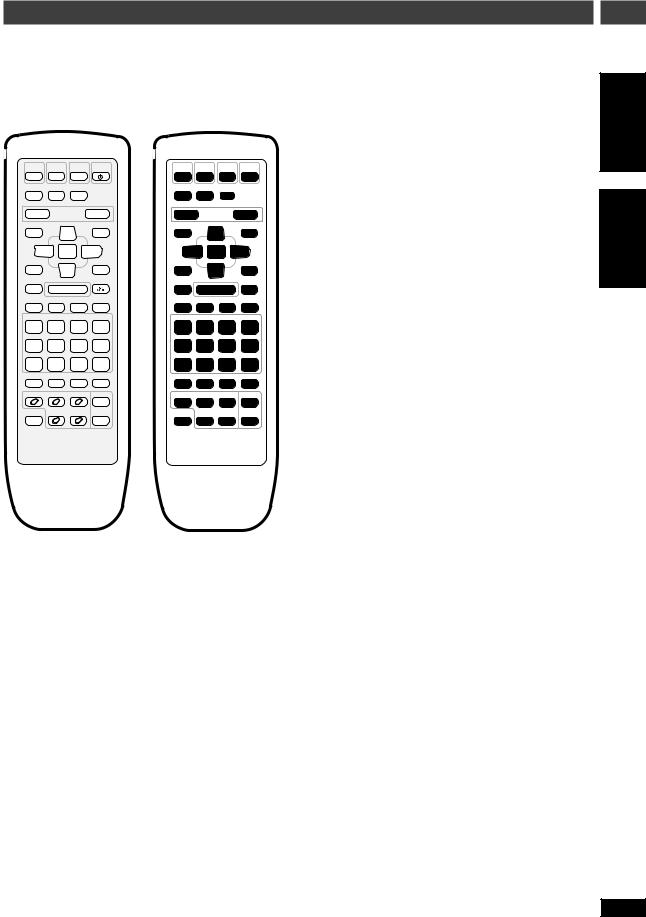
Commandes et affichages |
3 |
Télécommande
DVD |
TUNER |
TV |
STANDBY |
|
|
|
|
/CD |
/BAND |
/AUX |
/ON |
|
|
|
|
|
|
|
|
1 |
2 |
3 |
4 |
MUTE |
TEST TONE SURROUND |
|
|
|
|
|
|
CH LEVEL |
MODE |
|
|
|
|
|
|
|
|
|
|
5 |
6 |
7 |
|
– |
VOLUME |
+ |
8 |
|
|
9 |
|
DVD SETUP |
|
|
SYSTEM SETUP |
|
|
|
|
|
5 |
|
10 |
11 |
|
12 |
|
|
|
|
|
|
|||
2 ENTER |
3 |
13 |
14 |
|
15 |
||
TOP MENU |
∞ |
|
16 |
17 |
|
18 |
|
MENU |
SOUND |
|
|||||
|
|
|
RETURN |
19 |
20 |
|
21 |
7 |
6 |
|
|
||||
– PREV eSTEP/SLOW E |
NEXT + |
22 |
23 |
24 |
25 |
||
4 |
1 |
¡ |
¢ |
||||
CONDITION |
LAST MEMO |
SEARCH |
DVD DISP |
|
|
|
|
1 |
2 |
3 |
CLEAR |
26 |
27 |
28 |
29 |
ANGLE |
MONO |
SLEEP |
FL DIMMER |
|
|
|
|
4 |
5 |
6 |
>10 |
30 |
31 |
32 |
33 |
PROGRAM |
RANDOM |
REPEAT |
REP A–B |
|
|
|
|
7 |
8 |
9 |
10/0 |
34 |
35 |
36 |
37 |
|
|
|
|
||||
CD MODE |
AUDIO |
SUBTITLE |
SYSTEM DISP |
|
|
|
|
|
|
|
|
38 |
39 |
40 |
41 |
DISC 1 |
DISC 2 |
DISC 3 |
DISC SKIP |
|
|
|
|
|
|
|
|
42 |
43 |
44 |
45 |
SHIFT |
DISC 4 |
DISC 5 |
OPEN/ |
|
|
|
|
CLOSE |
46 |
47 |
48 |
49 |
|||
|
|
|
0 |
||||
1DVD/CD Pages 29, 51
2 TUNER/BAND Pages 33, 35, 51
3 TV/AUX Pages 35, 51
4STANDBY/ON Page 29
5 MUTE Coupe/rétablit tous les sons.
6 TEST TONE/CH LEVEL Page 26
7 SURROUND MODE Pages 25, 38
8VOLUME – Baisse le volume.
9 VOLUME + Augmente le volume.
10DVD SETUP Pages 27, 57
11Curseur vers le haut Sert à naviguer parmi les menus et les affichages à l’écran.
12SYSTEM SETUP Pages 23-24, 35, 52, 54-55
13Curseur vers la gauche Sert à naviguer parmi les menus et les affichages à l’écran.
14ENTER
15Curseur vers la droite Sert à naviguer parmi les menus et les affichages à l’écran.
16MENU Page 32
TOP MENU Page 32
17Curseur vers le bas Sert à naviguer parmi les menus et les affichages à l’écran.
18SOUND Pages 39-40
197 Page 30
203/8Page 30
21RETURN  Page 32
Page 32
224 / –PREV Pages 30, 32
231/ STEP/SLOW ePages 30-31
24¡/ STEP/SLOW EPages 30-31
25¢ / NEXT+ Pages 30, 32
261 / CONDITION (SHIFT & 1) Page 49
272 / LAST MEMO (SHIFT & 2) Page 48-49
283 / SEARCH (SHIFT & 3) Page 41
29CLEAR Supprime/annule plusieurs fonctions
DVD DISP (SHIFT & CLEAR) Page 50
304 / ANGLE (SHIFT & 4) Page 42
315 / MONO (SHIFT & 5) Page 34
326 / SLEEP (SHIFT & 6) Page 53
33>10 Sélectionne les numéros supérieurs à 10 Page 30
FL DIMMER (SHIFT & >10) Page 68
347 / PROGRAM (SHIFT & 7) Page 45
358 / RANDOM (SHIFT & 8) Page 46
369 / REPEAT (SHIFT & 9) Pages 46-47
37REP A–B (SHIFT & 10/0) Page 47
10/0 Touche numérotée (10 et 0)
38CD MODE Page 47
39AUDIO Pages 42-43
40SUBTITLE Page 42
41SYSTEM DISP Page 23
42DISC 1 Page 30
43DISC 2 Page 30
44DISC 3 Page 30
45DISC SKIP Pages 29-31
46SHIFT Maintenez pressé pour accéder aux fonctions secondaires de la touche
47DISC 4 Page 30
48DISC 5 Page 30
49OPEN/CLOSE 0Pages 29, 31
aisçFran English
21
Fr

3 Controls & Displays |
Commandes et affichages |
Display |
Afficheur |
1 |
|
2 |
|
3 |
|
4 |
|
5 |
|
6 |
|
7 |
|
8 |
|
9 |
|
10 |
|
11 |
|
12 |
2DIGITAL |
2PRO LOGIC |
MIDNIGHT |
CONDITION |
ANGLE |
LAST MEMO |
||
|
|
|
|
|
L |
C |
R |
ALL DISCS |
|
|
|
|
|
LFE |
|
|
|
|
|
|
|
|
|
RANDOM |
|
|
|
|
Ls |
S |
Rs |
REPEAT |
|
|
|
|
|||
|
|
|
|
|
|
|
|
17 |
|
16 |
|
15 |
|
14 |
|
13 |
1 |
DTS Page 71 |
1 |
DTS Page 71 |
2 |
2DIGITAL Pages 37, 70 |
2 |
2DIGITAL Pages 37, 70 |
3 |
2PRO LOGIC Page 37 |
3 |
2PRO LOGIC Page 37 |
4 |
Timer indicator Pages 51-52 |
4 |
Indicateur minuterie Pages 51-52 |
5 |
Sleep indicator Page 53 |
5 |
Indicateur sommeil Page 53 |
6 |
Tuned indicator Page 34 |
6 |
Indicateur d’accord Page 34 |
7 |
FM stereo indicator Page 34 |
7 |
Indicateur FM stéréo Page 34 |
8 |
FM mono indicator Page 34 |
8 |
Indicateur FM mono Page 34 |
9 |
MIDNIGHT Page 40 |
9 |
MIDNIGHT Page 40 |
10 |
CONDITION Page 49 |
10 |
CONDITION Page 49 |
11 |
ANGLE Page 42 |
11 |
ANGLE Page 42 |
12 |
LAST MEMO Pages 48-49 |
12 |
LAST MEMO Pages 48-49 |
13 |
Channel indicators Show which channels are available |
13 |
Indicateurs de canaux Indiquent les canaux |
|
on the current disc. |
|
disponibles sur le disque actuel. |
14 |
Character display When playing discs : Left to right |
14 |
Affichage des caractères À la lecture de disques. |
|
displays disc number, title, chapter/track, minutes, seconds. |
|
Affiche de gauche à droite le numéro de disque, le titre, le |
15 |
RANDOM Page 46 |
|
chapitre/la piste, les minutes, les secondes. |
16 |
REPEAT Pages 46-47 |
15 |
RANDOM Page 46 |
17 |
DISC | ALL DISCS Indicates the random or repeat |
16 |
REPEAT Pages 46-47 |
|
mode ; page 47 |
17 |
DISC | ALL DISCS Indique le mode aléatoire ou le mode |
|
|
|
de répétition ; pages 47. |
22
En/Fr

STANDBY /ON
SYSTEM SETUP
5
2ENTER 3
∞
SYSTEM DISP
Setting Up
Switching on and setting the clock
This system has a built-in clock, which needs to be set to be able to use the timer features.
1 Press to switch on.
to switch on.
2Press SYSTEM SETUP.
3Press the 2 or 3 button until you see TIMER in the display.
4Press ENTER.
5Press 2 or 3 until you see
CLOCK ADJ in the display.
6Press ENTER.
The display shows a clock, with the hour blinking.
7Use the 5 and ∞ buttons to set the hour, then press ENTER.
8Use the 5 and ∞ buttons to set the minute, then press ENTER.
The display blinks to indicate that the time has been set.
• Press SYSTEM DISP anytime to see the clock when the system is on or in standby.
Configuration 4
|
Mise sous tension et |
English |
|||
|
réglage de l’horloge |
||||
|
|
||||
|
Cet appareil a une horloge intégrée qui |
|
|||
|
doit être réglée pour pouvoir utiliser les |
|
|||
|
caractéristiques de la minuterie. |
|
|||
|
|
|
|
||
1 |
Appuyez sur |
|
pour mettre |
|
|
|
|
Français |
|||
|
l’appareil sous tension. |
|
|||
2 |
jusqu’à ce que vous voyiez |
|
|||
Appuyez sur SYSTEM SETUP. |
|
|
|||
3 |
Appuyez sur la touche 2 ou 3 |
|
|
||
|
TIMER sur l’affichage. |
|
|
||
|
|
|
|||
4Appuyez sur ENTER.
5Appuyez sur 2 ou 3 jusqu’à ce que vous voyiez CLOCK ADJ sur l’affichage.
6Appuyez sur ENTER.
L’afficheur montre une horloge avec les heures qui clignotent.
7Utilisez les touches 5 et ∞ pour régler les heures, puis appuyez sur ENTER.
8Utilisez les touches 5 et ∞ pour régler les minutes, puis appuyez sur ENTER.
L’afficheur clignote pour indiquer que l’heure a été réglée.
Astuce
• Appuyez sur SYSTEM DISP à tout moment pour voir l’horloge quand l’appareil est sous tension ou en veille.
23
En/Fr
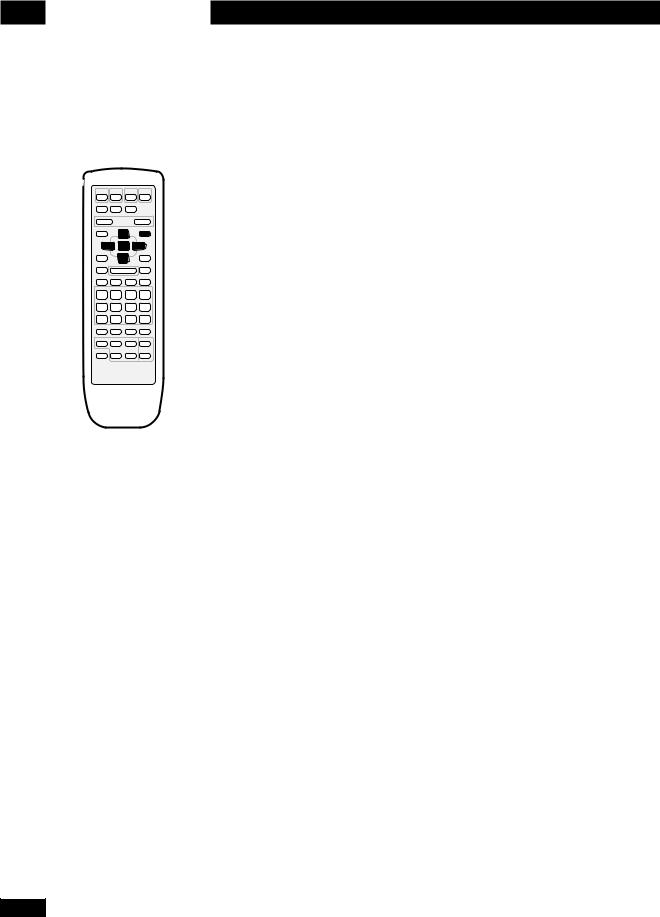
4
SYSTEM SETUP
5
2 ENTER 3
∞
24
Setting Up |
Configuration |
Setting up for surround sound
You can use this system right out of the box for surround sound with just the default settings. However, for really great surround sound, we recommend that you spend a few minutes making some settings that match this system to your listening room. Unless you change the layout of your speakers or main listening position, you only need to make most of these settings once.
Setting the speaker distances
1Press SYSTEM SETUP.
2Press the 2 or 3 button until you see FRT. SP in the display.
3Use the 5 and ∞ buttons to set the distance from your main listening position to the front speakers.
Ideally, your listening position should be equidistant from the two front speakers.
The default setting is 3m. You can adjust the range from 0.3m to 9.0m in steps of 0.3m.
4Press 3 to move on to the
CENTER speaker setting.
5Use the 5 and ∞ buttons to set the distance from your main listening position to the center speaker.
The default setting is 3m. You can adjust the range from 0.3m to 9.0m in steps of 0.3m.
6Press 3 to move on to the
SURROUND speakers setting.
Configuration du son surround
Vous pouvez utiliser cet appareil directement tel qu’il est fourni dans l’emballage pour obtenir une qualité du son surround en utilisant simplement le réglage par défaut. Cependant, pour obtenir un son surround meilleur, nous recommandons de prendre quelques minutes à faire quelques réglages pour accorder l’appareil à votre salle d’écoute. À moins que vous changiez la disposition de vos enceintes ou la position d’écoute principale, vous n’avez besoin de faire ces réglages qu’une seule fois.
Réglage de la distance des enceintes
1Appuyez sur SYSTEM SETUP.
2Appuyez sur la touche 2 ou 3 jusqu’à ce que vous voyiez FRT.SP sur l’afficheur.
3Utilisez les touches 5 et ∞ pour régler la distance à partir de votre position principale d’écoute jusqu’aux enceintes avant.
La position d’écoute idéale devrait être équidistante à partir des deux enceintes avant.
Le réglage par défaut est 3m. Vous pouvez régler la portée entre 0,3m et 9,0m par pas de 0,3m.
4Appuyez sur la touche 3 pour aller jusqu’au réglage d’enceinte CENTER.
5Utilisez les touches 5 et ∞ pour régler la distance à partir de votre position principale d’écoute jusqu’à l’enceinte centrale.
Le réglage par défaut est 3m. Vous pouvez régler la portée entre 0,3m et 9,0m par pas de 0,3m.
6Appuyez sur 3 pour aller jusqu’au réglage des enceintes SURROUND.
En/Fr
